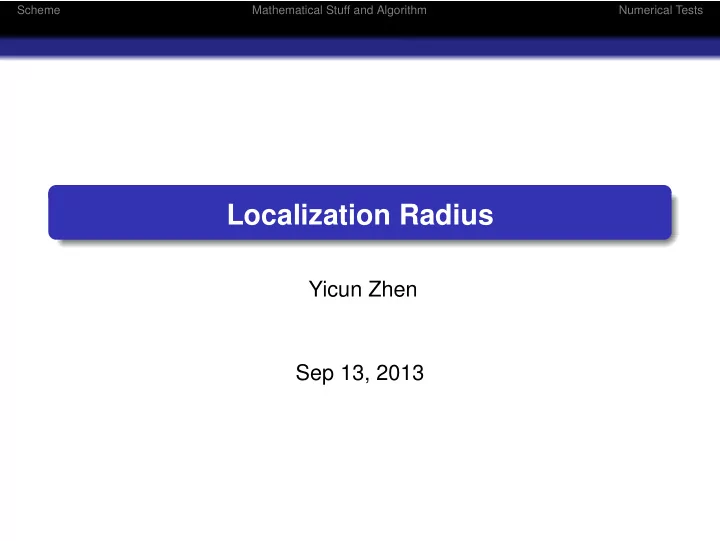

Scheme Mathematical Stuff and Algorithm Numerical Tests Localization Radius Yicun Zhen Sep 13, 2013
Scheme Mathematical Stuff and Algorithm Numerical Tests Outline Scheme 1 Mathematical Stuff and Algorithm 2 Numerical Tests 3
Scheme Mathematical Stuff and Algorithm Numerical Tests Steps Define a cost function F compute the value of cost function for several different localization parameter λ choose the λ that gives the least value of F use that λ to do sequential localized EnKF Question How to define the cost function λ ? Definition in last time Fix the influence radius for each observation y o i , and compute the mean difference of the updates for the localized and un-localized sequential EnKF .
Scheme Mathematical Stuff and Algorithm Numerical Tests cost function in the last time n � � ( r s ij ρ λ ( d ij ) − r ij ) 2 p ( B | S ) dB F ( λ, i ) = j = 1 where n is the number of gridpoints in the neighbor region in consideration.
Scheme Mathematical Stuff and Algorithm Numerical Tests notation r s ij is the sample regression coefficient of using observation y o i to update mean state at grid point x j X mean ← X mean + r s ij ∆ y i j j r ij is the true regression coefficient of using observation y o i to update mean state at grid point x j X mean ← X mean + r ij ∆ y i j j Critical problem with last cost function The resulting λ is always equal to 0 which means no localization is needed.
Scheme Mathematical Stuff and Algorithm Numerical Tests New cost function F ( λ, n ) = F V ( λ, n ) − F E ( λ, n ) where F E is an updating effect function F V is a pseudo-variance function
Scheme Mathematical Stuff and Algorithm Numerical Tests Definition of F E and F V n � � � � [ r 2 i − ( r s i ρ λ ( d i ) − r i ) 2 ] p ( B s | B ) p ( B ) dB F E ( λ, n ) = C ( S ) (1) i = 2 where C ( S ) is a constant depending only on the sample and n such that: � p ( B s | B ) p ( B ) dB = 1 C ( S ) (2) And we define the variance-like function: n � � � � ρ λ ( d i ) 2 ( r s i − r i ) 2 p ( B s | B ) p ( B ) dB F V ( λ, n ) = C ( S ) (3) i = 2
Scheme Mathematical Stuff and Algorithm Numerical Tests Theorem � ∞ 1 t N − n − 1 0 e − 1 2 t 2 n 1 1 + | ǫ 1 | 2 dt 1 � � rt 2 � − ρ 2 λ ( d i ) θ 2 F E ( λ, n ) = 2 ρ λ ( d i ) θ i e i (4) � ∞ i 0 e − 1 2 t 2 1 t N − n − 1 dt 1 i = 2 1 � ∞ 1 t N − n − 1 0 e − 1 2 t 2 1 + | ǫ 1 | 2 dt 1 n � 1 rt 2 � ρ 2 θ 2 F V ( λ, n ) = λ ( d i ) i − 2 θ i e i + � ∞ 0 e − 1 2 t 2 1 t N − n − 1 dt 1 i = 2 1 � ∞ t N − n − 1 0 e − 1 2 t 2 � ∆ ii | ǫ 1 | 2 1 + | ǫ 1 | 2 ) 2 dt 1 1 � 1 ( rt 2 � N − n − 1 + e 2 (5) � ∞ i 0 e − 1 2 t 2 1 t N − n − 1 dt 1 1
Scheme Mathematical Stuff and Algorithm Numerical Tests Algorithm Have some value of λ in mind. For each observation y o i and for those λ , find the influence radius (hence n λ )for each λ compute the value of the new cost function F for each λ and find the λ that corresponds to the minimum F value. Hence for each observation y o i we have a unique λ i that is optimal for y o i Use any method (for example, kernel density estimation) to find the maximum likelihood of λ use the maximum likelihood λ to be the λ we use in this assimilation cycle. computational cost O ( N 3 m )
Scheme Mathematical Stuff and Algorithm Numerical Tests Notations Model: Lorentz 96. n: number of variables. m:number of observations. N: ensemble size.
Scheme Mathematical Stuff and Algorithm Numerical Tests Set 1 n=40,m=20,N=31,41,51,61 (a) N=31 (b) N=41 (c) N=51 Conclusion: larger ensemble size ⇒ larger localization radius (d) N=61
Scheme Mathematical Stuff and Algorithm Numerical Tests Set 1 n=40,m=20,N=31,41,51,61 (d) N=31 (e) N=41 (f) N=51 Plot of F values at different observation (g) N=61
Scheme Mathematical Stuff and Algorithm Numerical Tests Set 2 n=48,N=51,m=12,16,24 (g) m=12,N=51 (h) m=16,N=51 (i) m=24,N=51 (j) m=12,N=31 (k) m=16,N=31 (l) m=24,N=31
Scheme Mathematical Stuff and Algorithm Numerical Tests Set 3 N=51,n=40,300,1000, m=20,150,500 (m) m=20,n=40 (n) m=150,n=300 (o) m=500,n=1000
Recommend
More recommend